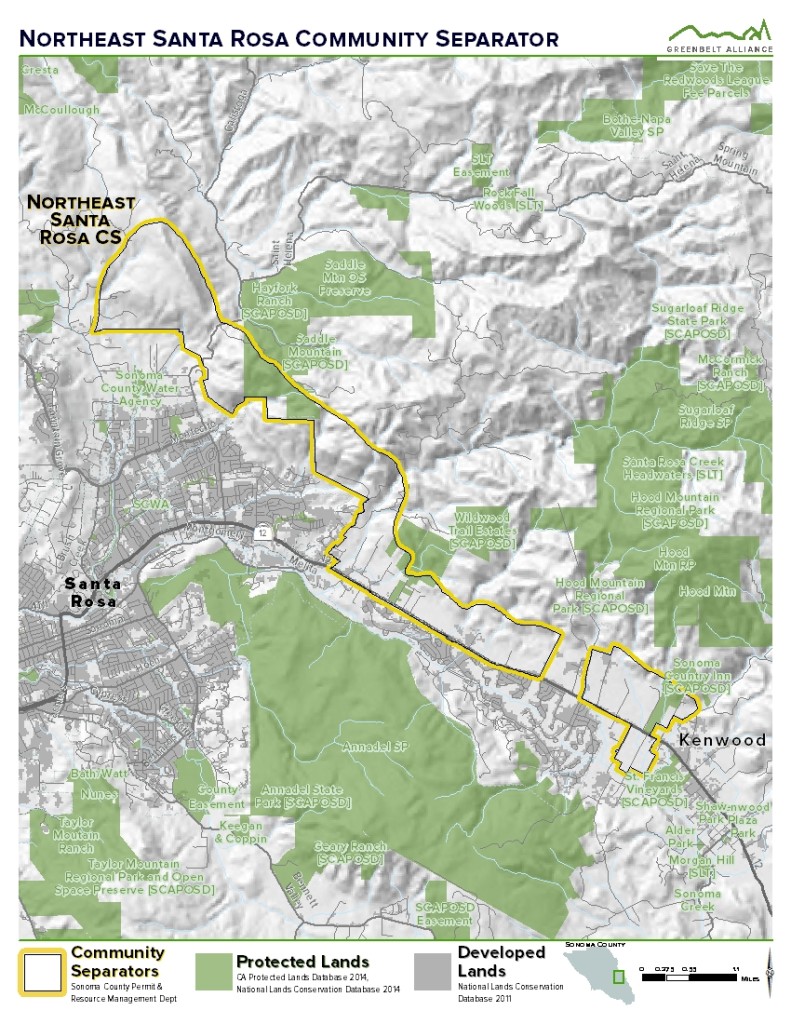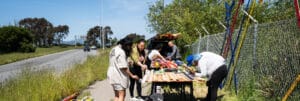Measure to curb urban sprawl set to expire next year
Many organizations concerned with the future of the county’s Community Separator program are being proactive about the impending sunset of the voter-approved measure coming up next year. A survey commissioned by the Greenbelt Alliance indicates strong voter support for not only re-approving the concept of preventing urban sprawl, but even strengthening it to include a wider area of protection, such as riparian habitat, and protecting drinking water, among others.
Community separators basically seek to preserve a greenbelt around each Sonoma County city by prohibiting increased building density without a public vote. They do not restrict any other permitted development within the designated zoning overlay. To qualify for a county mandated community separator, each city had to establish its own Urban Growth Boundary – a limit on how far the city would seek to expand in the future.
With a few exceptions for schools, fire departments and other public interest developments, the community separator concept has been successful: there have been no increased density developments within them for the past 18 years, though there have been developments, such as Kenwood’s La Campagna/Sonoma Country Inn on the Graywood Ranch property, which was permitted through an exception for “overriding considerations,” such as enhanced tax revenue.
Two years ago, the county’s Board of Supervisors budgeted time and resources for its Permit and Resource Management Department (PRMD) to examine the effect of the community separators and what to do when they expire. A PRMD analysis is expected to be delivered before the end of the year. The direction was to review and strengthen General Plan community separator policies.
However, as far as strengthening the law, Board of Supervisors Chair Susan Gorin said, “PRMD has limited resources to work on the necessary outreach to consider adding extensive land to the separators, in anticipation of a ballot initiative.”
The process for renewal of a similar or expanded community separator law involves either the supervisors putting it on the ballot, or it being created through a voter petition, requiring nearly 15,000 signatures in Sonoma County. The former is the preferred process of just about everyone concerned.
A wide range of interested people gathered at the Sonoma Land Trust office in Santa Rosa on Oct. 8 to hear the Greenbelt Alliance survey findings. Those present included representatives from the Sonoma Ecology Center, the Sonoma Valley Citizens Advisory Commission, Valley of the Moon Alliance, Sonoma County Conservation Action, Sonoma Land Trust, Wine & Water Watch, American Farmland Trust, Leadership Institute for Ecology and the Economy, Greenbelt Alliance, Preserve Rural Sonoma, and city council members from Santa Rosa and Petaluma.
The key findings of the Greenbelt voter survey, undertaken by FM3, found that while less than a third of the 400 people surveyed had even heard of community separators, 89 percent of them found the concept very positive (60 percent) or somewhat positive (29 percent). According to FM3 partner Dave Metz, protecting greenbelts, preventing resorts and luxury developments in separators, preserving scenic views, preserving farmlands, limiting growth and development, and concentrating new housing units near one another are high priorities among those surveyed.
Sonoma County’s eight community separators cover 17,000 acres around its cities, with 3,300 acres set aside for Northeast Santa Rosa, which stretches from Calistoga Road down to Adobe Canyon on the east side of Sonoma Highway. The Glen Ellen/Agua Caliente separator covers 1,400 acres, again on the east side of the highway.
The separators are encompassed by the county’s General Plan, which also envisions future greenbelt protections for Cloverdale and Penngrove.
“We need to start now to renew and strengthen our legacy of thriving landscapes, communities, and livelihoods,” said Teri Shore, director of the Sonoma chapter of the Greenbelt Alliance and host of the meeting.
Possible opposition to community separators could come from housing advocates looking for more space to build both affordable and mainstream housing in an extremely tight real estate market.
“The political question of enough supervisor support for placing an initiative on the ballot is something I can’t answer yet,” Gorin said. “We have not had an opportunity to talk together about this. Placing this on the ballot is one question, but planning and funding a campaign for this is another.”
Whatever is going on the ballot must be decided by August 2016. If the supervisors do it, it will need to get started by February, with a PRMD study and public review by both the Planning Commission and Board of Supervisors over the spring and summer.
In all, 2016 promises to be a very big political year, with a presidential election as well as three supervisor jobs on the line and an increasing struggle between preservation and growth elements in the county.
This article was originally published by the Kenwood Press.





